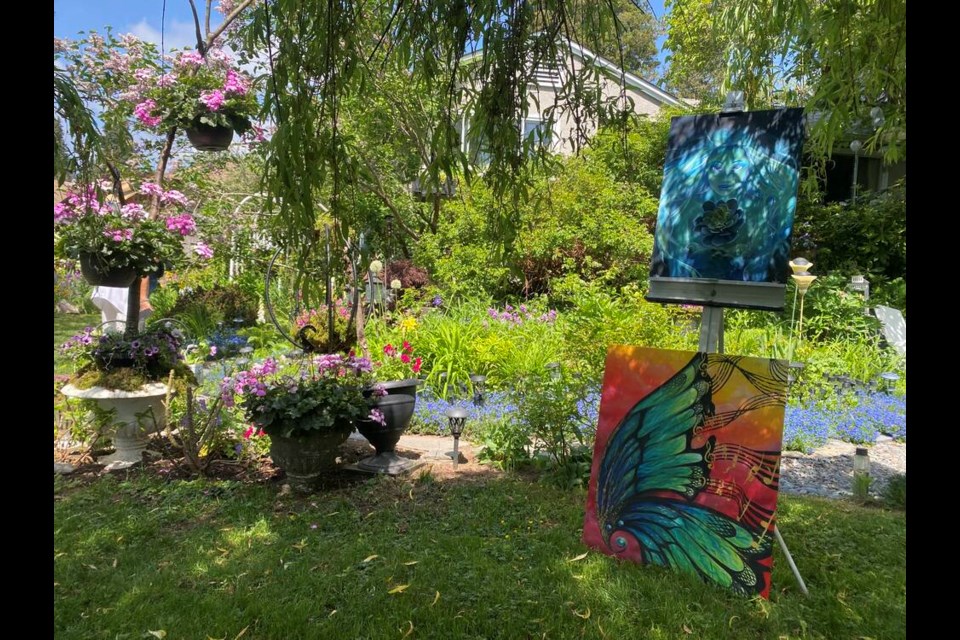Ask any creative what qualifies as art and they will tell you that art is multifaceted, spanning everything from music and performance to paintings, sculpture, sketch and - to some especially green-thumbed creatives - a meticulously curated garden.
This weekend gardens across the North Shore celebrated all things aesthetically pleasing for Arts in the Garden, a community event that fuses all facets of artistic creation by putting together visual artists, musicians and live performers in the same space.
The annual event, presented by North Van Arts, comprised 13 blooming gardens that traversed themes from ‘engaging’ - a garden with thought-provoking artwork and an active garden with bubbling ponds - to ‘connected’ - another filled with interconnected, meandering trails and musicians who sang on the on the healing power of trees.
“This natural environment lends itself so well to art. Galleries are very restrictive, you’re in a very sterile environment, but this inspires creativity, more authentic conversation,” said Garrett Andrew Chong, a photographer whose images had poked out from flourishing flower beds in a garden on West Vancouver’s Marine Drive.
For the artists participating, the event gave them the opportunity to get out of the stuffy confines of gallery and workspace, and allowed their wares to be viewed and appreciated by a wider audience.
“This is a really, really nice opportunity, this is a very different demographic to where I live, a much different crowd, and it means I can showcase all the different things that I work on,” said artist Emily Picard, an artist from the Sunshine Coast.
Like many of the artists participating, Picard’s creations complemented the space it inhabited. The eclectic nature of her work - Picard’s mediums span acrylic paint, spray paint, watercolour and marker pens - slotted in seamlessly to a garden that was anything but minimalistic.
Aptly categorised under “Ethereal” the North Vancouver garden, number 7 on the tour, had been like a scene from Alice’s Wonderland, complete with chandeliers hanging from the trees - 75 in total - birdcages protruding from flower beds and crystal dinnerware scattered large silvered tables.
Gardener Susan Bath, who has spent 27 years putting the outdoor scene together, said she hopes her mystical greenspace will inspire creativity within all who enter, and will encourage them to embrace whimsy in all its forms.
“I hope this shows that you don’t necessarily have to hire a professional, or be a professional, to create in this way. You don’t need a landscape artist, you don’t need money or a large garden, you just need time and a sense of playfulness,” she said, adding how most pieces had been gifted, bought from charity stores, or picked up from the side of the road.
While some gardens transported guests to Lewis Carroll lands, others set the scene for education. At Garden number 9, dubbed ‘Energized’, the LifeSpace Gardens hosted fellow green thumbs and offered tips and information on urban farming and vegetable growing.
At “Harmony”, garden number 4 on West Vancouver’s Whonoak Road, a fourteen year old food forest on Sḵwx̱wú7mesh Úxwumixw (Squamish Nation) land invited guests to learn about Indigenous plants and healing.
“This is an educational space, where people can come and pick different things that they need from our community, anytime of the year,” said Senaqwila Wyss, the garden’s host, adding how the garden is open to all who want to learn.
Wyss said the event provided the opportunity for guests to learn the names of herbs and plants in the Sḵwx̱wú7mesh Sníchim (Squamish language), to learn of Indigenous foods themselves - like the Indigenous wild potato wapato that has been making a comeback in local soil - and to immerse themselves in Squamish culture. Within the garden, musician Rennie Nahanee had delivered song and Squamish storytelling, talking of Elders and canoe experiences.
Whether hosting Indigenous storytelling or abstract art, each garden, said Tary Majidi, artist at the Marine Drive offering, should provoke some sort of response from guests. It should inspire them to create or to engage, to connect with other people more or to just appreciate the smaller, more natural, everyday things in life.
“We could all do with getting off the internet, off social media, and going back to art and going back to the natural world, enjoying nature or clay or paint,” she said.
“If there is one thing that people should take away from this event, it’s that art can heal and that should not be overlooked,” she said.
Mina Kerr-Lazenby is the North Shore News’ Indigenous and civic affairs reporter. This reporting beat is made possible by the Local Journalism Initiative.



